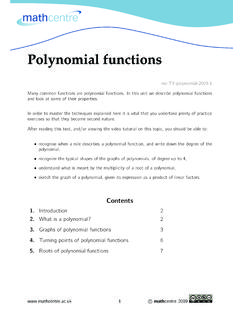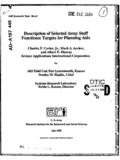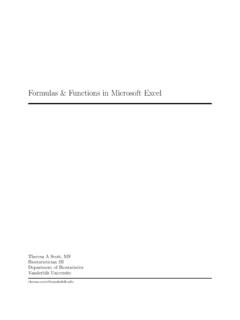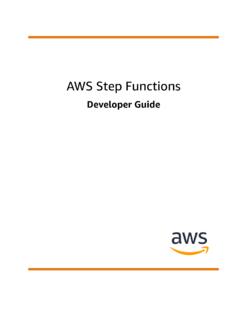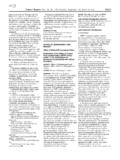Transcription of 083-2011: Developing User-Defined Functions in …
1 1 Paper 083- 2011 Developing User-Defined Functions in SAS : A Summary and Comparison Songfeng Wang, University of South Carolina, Columbia, SC Jiajia Zhang, University of South Carolina, Columbia, SC ABSTRACT In this paper we review the methods for SAS users to write their own Functions . These methods include SAS macro, SAS/IML, SAS Component Language (SCL), and two recently available procedures: PROC FCMP and PROC PROTO. We give examples showing how to make user Functions using each method. The computation time of different methods is investigated.
2 The pros and cons of each method are summarized, which can give SAS users basic ideas about choosing the appropriate method according to their own purposes. INTRODUCTION SAS programs usually consist of a number of DATA steps or built-in PROC steps. Compared to other command-based or object-oriented programming languages, it is not straightforward for SAS users to write their own Functions . SAS macro has played an important role for users to re-use some of their code without doing much cut-and-paste for a long time. SAS/IML and SAS Component Language (SCL) also provide possibilities for users to implement Functions -like modules and methods into their programs.
3 Nowadays, with the introduction of PROC FCMP and PROC PROTO, SAS users can have more options and flexibility in Developing and programming the Functions they want. In this paper, we go over the existing methods with examples to show how to use these methods, and then comparisons of these methods are made. SAS MACRO SAS macro has a long history of being used as the major alternative for user -developed Functions . According to SAS Marco language reference, the macro facility is a tool for extending and customizing the SAS system and for reducing the amount of text you must enter to do common tasks.
4 The simplest type of SAS macro facility is macro variables, which are substituted into your program wherever the macro variables are referenced. So the basic idea behind macro variables is text substitution. Macro variables can be useful when common tasks are to be performed to different values by simply changing the values of the macro variables. Similar to macro variables, macro programs provide a way to substitute text into SAS programs. Macro programs can be written to run a set of DATA steps or procedures repeatedly, and therefore a batch of similar tasks can be done by reusing the same code.
5 Conditional logic and decisions are available in macro programs, so the macro programs can be flexible and dynamic enough for complicated tasks. Furthermore, SAS macro facility provides a variety of macro statements and Functions to make the coding easier and more efficient. There are four ways to make macros available to current programs: to compile a macro and use it for current sessions, to save it as a permanent macro and then use a %INCLUDE statement, to call it through the autocall facility, or stored it as a compiled macro. A macro variable is defined with %LET statement and referenced by preceding the macro variable name with an ampersand (&).
6 A macro program usually starts with %MACRO statement, and then includes SAS data set and variable names, SAS or macro statements and procedures, and it ends up with a %MEND statement. Example 1: Here is a simple example of using macro to find the larger value of two integers. If you need to include source code: %macro max(dat); data _null_; set if x>=y then put x=; else put y=; %mend; data temp; input x y; cards; 7 3 ; run; Coders' CornerSASG lobalForum2011 2 %max(temp); The above macro program defines a macro program max, which can refer to a SAS dataset dat.
7 When we call the macro with %max(temp), &dat is replaced with temp and the code looks like this: data _null_; set temp; if x>=y then put x=; else put y=; It prints x=7 in the log window. However, due to the basic idea of macro is text substitution, Developing SAS macro may not be very intuitive and straightforward for users who are more familiar with statistical languages like R/S-plus or STATA. Another issue is that although SAS macro can be easily shared by others, the code is not very easy to read, modified or maintained. Example 2: This example is about calculating the value of from the infinite series.
8 We are interested in a function that can take the length of the series as a parameter. A macro corresponding to this function is described as below. %macro calpi(niter=); data pi; temp=0; do i=1 to temp=temp+4*(-1)**(i+1)*1/(2*(i-1)+1); end; put temp; run; %mend; %calpi(niter=5000); The above macro uses a series with a length of 5000, and it prints in the log window. Example 3: Let s take a look at a more complicated example. Suppose we would like to perform a Monte Carlo simulation to investigate the coverage probability of 95% confidence intervals for coefficients in a linear regression model.
9 The model is specified as , where , , and . A macro named covsim is created, which has the following parameters: the number of datasets (nsim), the sample size of each dataset (nsize), the true values of parameters (beta0, beta1, beta2), and the seed used to generate the random error (seed). The macro uses PROC GENMOD to fit a regression model for each simulated dataset, and then uses ODS OUTPUT to save the 95% CI from each simulation into a dataset named parestimate. The coverage probability can then be derived from this dataset accordingly.
10 %macro covsim(nsim=, nsize=, beta0=, beta1=,beta2=, seed=, simout=); data * generate the datasets ; do sim = 1 to do index=1 to x1=RANUNI(12345); x2=RANBIN(12345,1, ); y = &beta0 + &beta1*x1+ &beta2*x2+RANNOR( output; end; end; run; ods output "Analysis Of Parameter Estimates"=parestimate; proc genmod data= class x2 /descending; model y=x1 x2 /d=n; Coders' CornerSASG lobalForum2011 3 by sim; run; ods output close; run; data temp; set parestimate; if Parameter="x1" & LowerWaldCL<=&beta1 & &beta1<=UpperWaldCL then cover1=1; else cover1=0; if Parameter="x2" & LowerWaldCL<=&beta2 & &beta2<=UpperWaldCL then cover2=1; else cover2=0; run; /**the coverage of beta1**/ proc freq data=temp; table cover1; where Parameter="x1"; run; /**the coverage of beta2**/ proc freq data=temp; table cover2; where Parameter="x2" & level1='1'; run; %mend; If we would like a simulation with 1000 datasets generated, 200 observations in each dataset, true coefficients of (1, 3, 2), and a seed of 123.)










